Key Takeaways
- Ethereum staking provides a potential for earning money while contributing to the network's security;
- There are several approaches on how to stake Ethereum that carry different levels of risk, reward, and technical expertise: solo staking, staking as a service, pooled staking, and centralized exchange staking;
- Be careful of slashing, a penalty system for validators who break the rules. This can lead to losing some or all of your staked ETH.
Stop overpaying - start transferring money with Ogvio. Join the waitlist & grab early Rewards NOW! 🎁
Want to turn your idle ETH into a steady stream of income? Ethereum staking might be your golden ticket. By locking up your ETH, you can not only contribute to the network's security but also earn rewards.
However, with various staking options out there – from solo staking to centralized exchanges – navigating the best path can be tricky. For example, platforms like Binance and Coinbase offer really user-friendly staking options, but it's essential to weigh the potential rewards against fees and other risks.
Get into the details together to help you make an informed decision! But first, let's discuss the basic concept.

Did you know?
Subscribe - We publish new crypto explainer videos every week!
How to Pick the Right DeFi dApp? (Dos and Don’ts Explained)


Table of Contents
What Is Ethereum Staking?
In short, Ethereum staking means that you lock up a certain amount of ETH, the native token of Ethereum, to become a validator to verify transactions and add new blocks to the Ethereum blockchain. As a reward for the service and for ensuring the security of the network, you earn new ETH tokens.
Latest Deal Active Right Now:Why is Ethereum staking important? Well, to put it simply, let’s imagine Ethereum as a giant digital ledger that keeps track of all transactions happening on the blockchain. This ledger needs to be secure and constantly updated, just like a bank ledger.
Traditionally, banks rely on trusted employees to meticulously verify every transaction. Meanwhile, Ethereum has no central authority because it’s a decentralized ledger of transactions[1]. So, how do we ensure the accuracy and security of these transactions? This is where Ethereum staking comes in.
This innovative system allows ETH holders to become validators, essentially taking on the role of those trusted bank employees.

By staking their own ETH, validators have the power to verify transactions and add them to the Ethereum blockchain. This staked ETH acts as a security deposit – if a validator tries to tamper with the system, they risk losing some or all of it. This strong incentive ensures validators act in the best interest of the network's security.
Initially, Ethereum relied on Proof-of-Work (PoW), similar to Bitcoin. This system required miners to solve complex equations using massive amounts of computing power. The first miner to solve the problem got the right to validate transactions and add them to the blockchain, earning rewards in the process. However, PoW used high energy consumption and potential centralization of mining power.
Therefore, in September 2022, Ethereum transitioned to a more efficient system called Proof-of-Stake (PoS). Here, the power comes from the value of staked ETH, not massive computer rigs. This shift not only benefits the environment but also opens doors for anyone with ETH to contribute to the network's security and earn income in the form of new tokens.
How Does Ethereum Staking Work?
As I’ve discussed shortly in the previous section, Ethereum staking essentially locks up your ETH for a period to make you a validator and verify transactions on the blockchain. In return of your service, you earn additional ETH.
Becoming a Validator
To become a validator, you need to "stake" a minimum of 32 ETH. This acts like a security deposit, showing your commitment to the network's health. After all, any malicious actions could result in you losing some or all of your own ETH.
Then, choose from popular Ethereum 2.0 clients like Prysm, Lighthouse, Teku, or Nimbus to configure your validator node. Those are your essential gateway to the network.
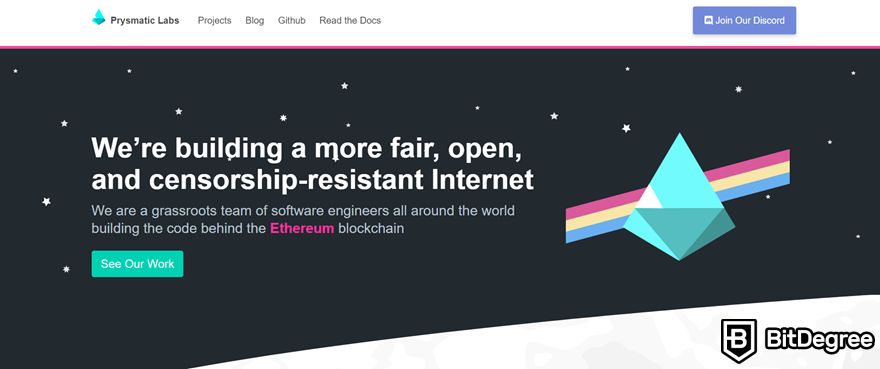
Imagine you want to participate in a global game of verifying transactions on Ethereum. This specialized software allows you to:
- Connect you to the network. The client acts as a bridge between you and the Ethereum network. It enables you to download the latest blockchain data, receive instructions on which transactions to validate, and submit the validations to the network.
- Perform validation tasks. The client software handles the technical aspects of validating transactions. It checks the validity of each transaction according to Ethereum's rules and helps you propose new blocks to the blockchain.
- Maintain network synchronization. A good client ensures your node stays in sync with the rest of the network. This means you have the latest information and can participate effectively in the validation process.
In short, the Ethereum 2.0 client is your essential toolkit for becoming a validator. It provides the necessary functionality to connect, validate, and contribute to the security of the Ethereum network. Caution: This process can be really technical.
Getting Selected
Unlike Proof-of-Work (PoW) where miners with the most computing power have an advantage, Ethereum 2.0 uses a random selection process. This ensures that everyone with the minimum staked ETH has a fair chance of being chosen, regardless of the amount they stake.

A complex cryptographic function called a RANDAO beacon generates a random number for each block. This number acts like a giant lottery ticket pool, and each validator's stake acts as their lottery ticket. The validator whose staked ETH value most closely matches a specific part of the number gets picked to propose the next block. This ensures a truly unpredictable and unbiased selection process.
In addition to the block proposer, a committee of other validators is also randomly chosen for each block. This committee helps with the validation process, making sure the proposed block is accurate and follows the rules.
Performing Validator’s Duties
Okay, let’s say you already become a validator in the Ethereum network. What are your duties? On the surface, it seems like you’re just locking up some ETH, but it’s actually more than that.
As a validator, you act as a meticulous accountant: checking every transaction on the network – whether the sender has enough ETH to complete the transaction, whether the transaction is properly signed with the sender's private key to prove ownership of the ETH, and whether the transaction follows all the pre-defined rules of the Ethereum network.

Validators also have the opportunity to propose the next block to be added to the blockchain. This block contains a bundle of validated transactions. Think of it as assembling a group of verified transactions into a neat package for permanent storage.
Once a block is proposed, other validators attest to its validity. This means they confirm that the proposed block adheres to the network rules and contains accurately validated transactions. Not all validators get to propose blocks, but all can participate in attestation.
Moreover, validators play a crucial role in reaching an agreement (consensus) on the state of the network. By proposing, validating, and attesting to blocks, they determine the official record of transactions on the blockchain together. This ensures that everyone on the network agrees on the same history of transactions, preventing forks or inconsistencies.
For successful validation, it's crucial for validators to be online 24/7. This is called uptime. A constantly connected validator can participate in all the validation processes and contribute effectively to the network's security.
Validator Rewards
After you work hard to perform the tasks as a validator, you receive some sweet perks – rewards in the form of a newly minted ETH! Think of it as a bonus for assembling a valid block of transactions. The amount of ETH a validator earns isn't random. It's based on several factors, both inside and outside of an individual validator’s control.
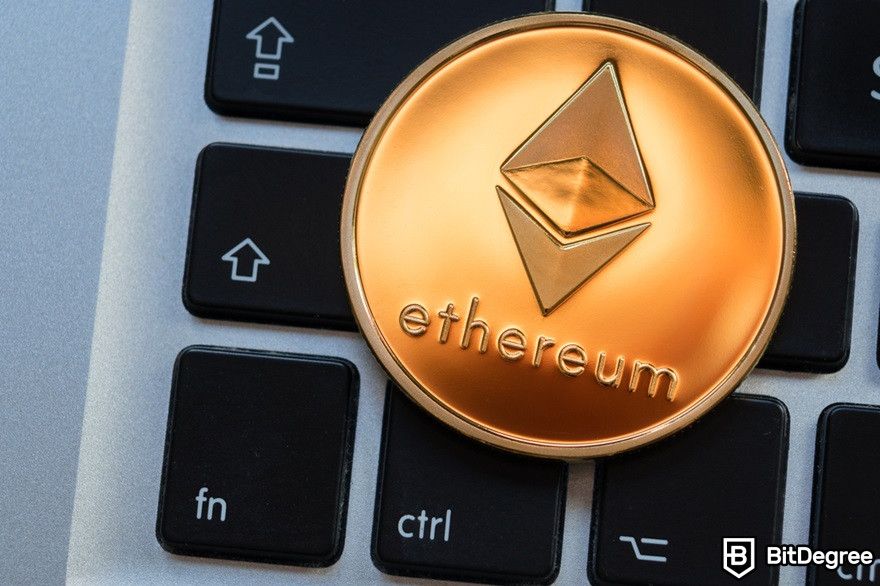
Don’t worry, Ethereum's reward system is completely transparent – open for everyone to see and verify and no one controls or influences how much validators earn. You can precisely predict your potential earnings based on the network's rules, and you have a clear, up-to-date record of all payments made to validators thanks to the public blockchain.
Some of the essential factors that influence how much ETH staking rewards a validator receives include:
- Validator uptime and performance. Validators who stay online and fulfill their duties consistently earn the most rewards. Minor slip-ups, like occasional downtime, result in small penalties. However, severe violations of network rules can lead to a much harsher punishment called "slashing," where validators risk losing a big portion of their staked ETH.
- Number of active validators. Ethereum wants to keep its network secure, and that requires a lot of people staking ETH. To make sure enough people participate, Ethereum adjusts the rewards for validators depending on how many are already on the network. Basically, if there aren't enough validators, the rewards per validator go up to make it more attractive. Meanwhile, if there are too many validators, the rewards per validator go down a bit.
- Block proposals and MEV. As I said, Ethereum picks validators for proposing blocks like a lottery, so anyone with enough ETH has a shot. Plus, the lucky validator who gets picked earns not only the regular rewards but also the transaction fees and any extra value they can squeeze out of the block (called MEV). It's like winning a prize with a bonus on top!
To conclude, becoming a validator on Ethereum 2.0 offers the chance to contribute to network security while earning rewards. However, it's not a passive activity. Consistent uptime, responsible behavior, and a bit of luck in the validator lottery are all crucial factors in maximizing your earnings.
Benefits of Staking Ethereum
Ethereum staking offers several advantages for both the network and individual users.
For the network, staking makes Ethereum more resistant to attacks compared to Proof-of-Work systems. Unlike PoW, where miners with the most computing power have more influence, staking uses a random selection process for validators, promoting a more decentralized network where no single entity has too much control.
Staking Ethereum, powered by the innovative Proof-of-Stake mechanism, offers a major advantage over Proof-of-Work mining[2]. It’s because the network doesn’t need massive computing power to complete energy-intensive calculations. This translates to a much lower environmental footprint for the Ethereum network and helps the network handle a growing number of transactions, allowing it to keep up with increasing demand.

Meanwhile, for the users, Ethereum staking enables them to earn rewards in the form of newly minted ETH, offering a way to generate passive income. In some cases, rewards can be higher compared to traditional investment options!
Another compelling benefit of staking ETH is the opportunity to influence the future direction of the Ethereum network. Validators, as significant stakeholders, are granted the power to participate in governance decisions.
For instance, stakers can directly vote on proposed changes to the Ethereum protocol. This includes everything from network upgrades and fee structures to the creation of new tokens and ecosystems within the Ethereum ecosystem.
By voting on proposals, they collectively influence the direction of Ethereum's development. This ensures the platform aligns with the needs and preferences of its community.
Stakers can also vote on proposals to remove or punish validators who misbehave or fail to meet their duties. This helps maintain the integrity of the network and protects the interests of all stakers.
Risks and Considerations
You may be excited due to the various benefits of Ethereum staking, but note that this activity has trade-offs to consider.
First, running a validator node requires technical expertise and continuous maintenance. Issues like downtime or software vulnerabilities can lead to missed rewards or, in extreme cases, slashing penalties which can result in the loss of a portion or even all of your staked ETH.
Not trying to scare you off, but slashing penalties can be a major setback for validators, though the network's security benefits are good. These penalties are meant to stop validators from cheating or being careless, which could harm the Ethereum network.

There are two main types of slashing penalties. The first one is called an inactivity slash, which occurs when a validator goes offline for a long period. This suggests the validator isn't fulfilling its duties of verifying transactions and proposing blocks. The penalty for inactivity can be a small portion of the validator's staked ETH, depending on the duration of the downtime.
The second one is double vote slash, a more serious offense that happens when a validator votes twice on the same block, or votes on conflicting blocks at the same time. This behavior can disrupt the network's consensus and potentially lead to forks. The penalty for double voting can be much harsher, potentially resulting in the loss of a significant portion or even all of the validator's staked ETH.
Besides slashing penalties, you should be aware of market volatility. The value of ETH can fluctuate significantly, meaning the overall worth of your staked ETH and the rewards you earn can go up or down
Also, note that staking ETH locks up your coins for a period. This means you won't be able to trade them freely or use them for other purposes while they're staked.
How to Stake Ethereum
After knowing the benefits, risks, and how it works, Ethereum staking has piqued your interest? Excellent! Now, let’s check out the four options below on how to stake Ethereum and go for the one that is best for you – your technical expertise, risk tolerance, and financial goals.
Solo Staking
Solo staking is the most hands-on approach to participating in Ethereum 2.0. You take on the full responsibility of running a validator node, directly contributing to the network's security.
Staking Ethereum with this method also lets you have complete control over your validator node's configuration and operation, allowing for advanced customization and a deeper understanding of the network. More importantly, you earn the highest potential ETH staking rewards.
However, you have to be ready with the technical requirements. Solo stakers must have a strong understanding of blockchain technology, client software, and server maintenance. They also need dedicated hardware to run your validator node 24/7. This includes a reliable computer with sufficient storage and a stable internet connection.

Moreover, don’t forget to prepare the minimum staking requirement: 32 ETH tokens, which is around USD 113,016.32 at the time of writing
If you’re a tech-savvy user who enjoys the challenge of managing their own validator node or someone with a long-term investment horizon and access to the required hardware and ETH, this method is for you!
To begin your solo ETH staking journey, have some hardware, sync Ethereum 2.0 clients, generate your keys, and load them into your validator client. Then, always monitor and maintain your node.
Staking as a Service
If you don't want to handle the technicalities of running your own validator, staking-as-a-service (SaaS) is a good option. You can delegate complex tasks to a third-party provider while still earning rewards.
These services typically require you to set up some basic information, including creating a set of validator credentials, uploading your signing keys to them, and transferring your ETH to their platform.
The main advantage is that you don’t need to worry about technical expertise or specialized hardware as the provider handles everything. You benefit from the expertise of the service provider in running validator nodes.
The drawback is that you may not be able to control your validator. Meaning, they could act dishonestly using your ETH, resulting in slashing penalties that impact your staked funds. Additionally, providers charge fees, which can influence your overall returns.

Therefore, always choose a reputable and trustworthy service provider and ensure that it offers slashing protection to mitigate potential losses. Choosing a subpar provider can lead to various issues, including loss of funds due to slashing penalties, downtime, or even security breaches. Additionally, there's always the risk of malicious behavior by employees, which could compromise your funds.
I also suggest that you carefully compare the fees charged by the service provider. Look for transparent fee structures and avoid hidden costs. Another way to limit the risk, keep the keys to withdraw your ETH yourself. That way, you maintain complete control over your funds.
Some popular options listed on the official Ethereum website are Kiln, P2P.org, and Consensys Staking. Note that this is not an endorsement. Before making a decision, it's important to do your own research and compare the features, fees, and security measures offered by different staking-as-a-service providers.
Pooled Staking
Pooled staking is a collaborative approach to Ethereum staking, where multiple individuals combine their ETH to form a staking pool. This method allows users with smaller amounts of ETH to participate in the network's security and earn rewards.
With pooled staking, you don't need to worry about setting up your own hardware because the pool operator handles the technical aspects of running a validator node. This includes managing the software, hardware, and network connectivity.
Some staking pools use smart contracts to automatically manage your staked ETH. You get a digital token representing your share in the pool. Other pools handle things manually, without using smart contracts.
Yes, it’s similar to staking as a service where you delegate your ETH to another person, but this approach has a lower barrier to entry as many staking pools let you stake virtually any amount of ETH.

What you have to consider is that pooled staking is not natively supported by the Ethereum protocol. This means it relies on smart contracts or off-chain mechanisms, which can introduce additional risks, such as smart contract hacks or exploits and potential mismanagement by the pool operator.
From the network’s perspective, pooled staking can lead to a concentration of power, although it allows more people to participate.
A small number of staking pools could end up controlling a large portion of the staked ETH, which goes against the decentralized principles of Ethereum. This centralization could create vulnerabilities, such as the possibility of censorship or network manipulation.

- Secure and reliable
- Accepts fiat currencies
- Lots of trading options
- Reputable exchange
- Accepts fiat currencies
- Offers various trading options

- Huge trading variety
- Regulation-compliant around the globe
- Fair trading fees
- Beginner-friendly
- A wide array of features
- Vast number of different crypto coins & tokens

- Beginner-friendly
- Secure
- Decent trading and withdrawal fees
- Crypto.com Visa Card
- Automated tools & bots
- Ecosystem synergy with CRO
Wallet and Centralized Exchanges
Some cryptocurrency wallets offer built-in staking functionality, which can be a convenient option, especially for users already familiar with a particular wallet.
A popular example is hardware wallets from Ledger. With any of their wallets and Ledger Live app, ETH staking can be initiated directly from the wallet interface, removing the need for setting up a separate validator node. The wallet handles the technical aspects of staking on your behalf.
To start, get your preferred Ledger wallet – like Ledger Nano S Plus or Ledger Nano X. Then, install Ledger Live on mobile or desktop to set up the device. Complete the security checklist as instructed on the app and choose your password. After that, install the app on your Ledger device and add your account to manage your assets.
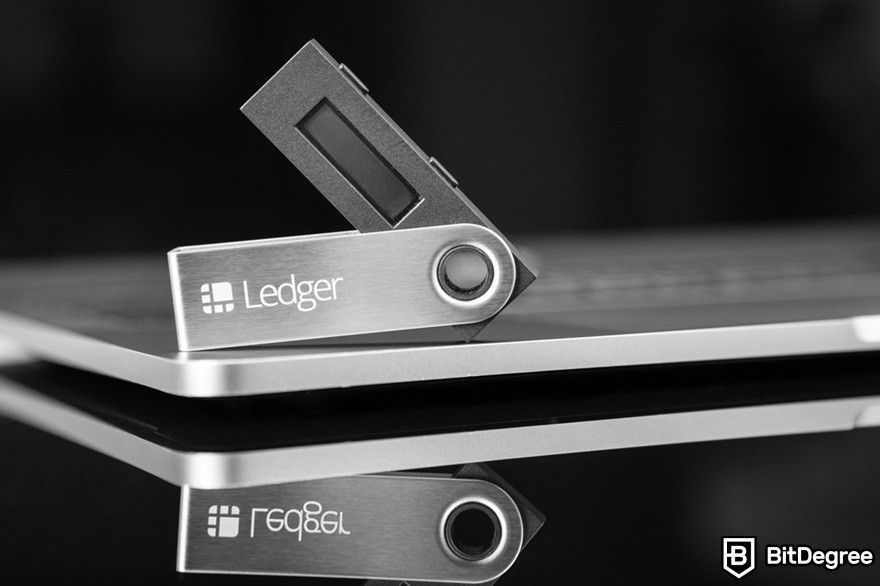
Next, use Ledger Live to buy ETH with their partners or transfer your asset from an exchange to the hardware wallet. To stake Ethereum on the device, click the Earn Rewards button on your ETH account or go to the Discover section and select Kiln or Lido. Ultimately, choose the amount to stake and confirm with your Ledger.
Besides crypto wallets, some centralized exchanges (CEXs) like Coinbase and Binance also offer Ethereum staking options. This is also a very user-friendly option, similar to buying and selling crypto. Moreover, the CEX handles all the technical aspects of staking.
CEXs often allow staking with smaller amounts of ETH compared to solo staking. On Binance, for example, you can stake Ethereum for only 0.0001 ETH and get 3.20% of ETH staking rewards.
To start Ethereum staking on Binance, you need to have a verified account with a sufficient ETH balance. After that, navigate to "Earn" or "Simple Earn" on the mobile app and search ETH token on the provided search bar. You can also find the ETH Staking menu on the Binance footer.
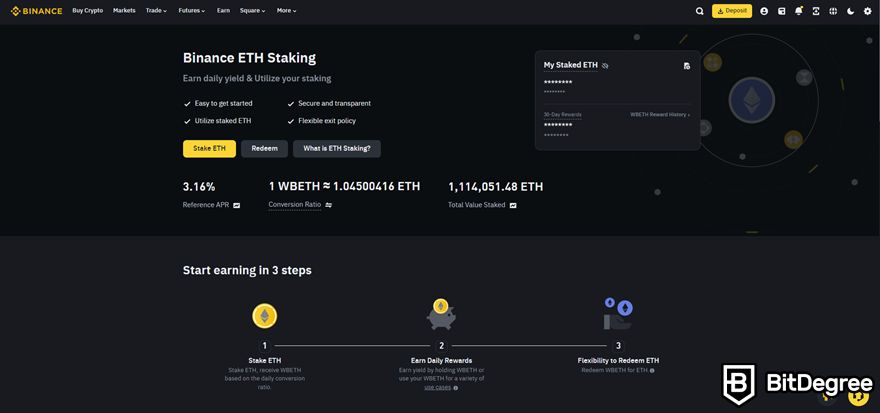
Choose the amount of ETH you want to stake, and confirm the transaction. Binance offers flexible staking periods, meaning you have the freedom to choose how long you want to lock up your ETH. Once your ETH is staked, you'll receive WBETH (Wrapped Beacon ETH) as a representation of your staked assets.
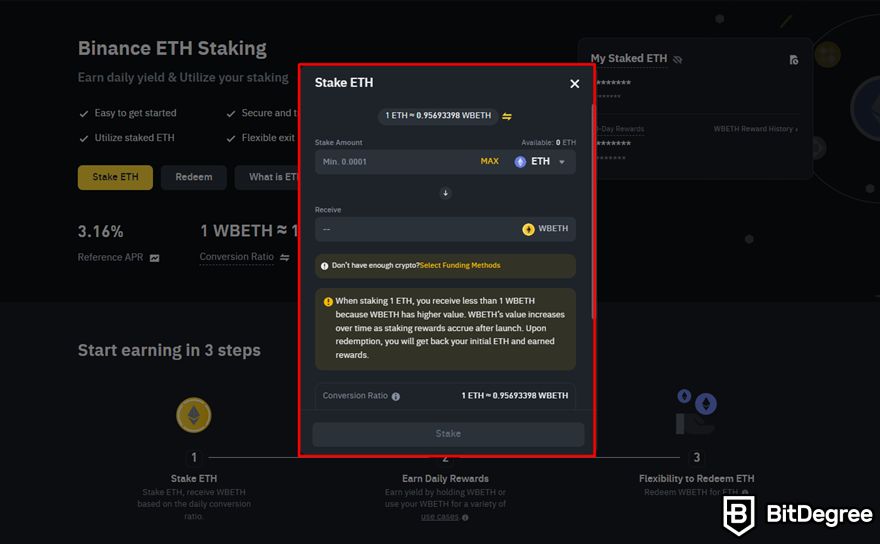
Note that the Binance interface and features may look different in certain countries.
I know that Ethereum staking on crypto wallets and exchanges seems convenient and accessible because they offer lower technical barriers and minimum stake requirements. However, this Ethereum staking option also has some drawbacks.
Some downsides of this method are lower potential rewards compared to solo staking and reduced control over your staked ETH. Additionally, you might face counterparty risk when relying on a third party to manage your stake.
If you're still confused about which method to stake Ethereum, I've created a table comparing the different options, outlining the key factors to consider, such as minimum stake, and technical expertise.
| Solo Staking | Staking as a Service | Pooled Staking | CEXs and Wallets | |
| Minimum Stake (ETH) | 32 | Variable | Lower | Very low |
| Technical Expertise | High | Low | Low | Not required |
| Control Over Stake | High | Medium | Low | Low |
| Potential Rewards | High | Medium | Medium | Low |
| Convenience | Low | High | Medium | Very high |
| Ideal For | Tech-savvy users with significant ETH, seeking maximum control and rewards | Users with limited technical expertise, looking for a hands-off approach | Users with smaller ETH amounts, seeking to reduce risk and participate in staking | Users prioritizing convenience and ease of use, with lower risk tolerance |
Table: The comparison of solo staking, staking as a service, pooled staking, and staking on CEXs or wallets.
As you can see, each staking method has its own advantages and disadvantages.
Solo staking offers the highest potential ETH staking rewards but requires a significant amount of technical expertise and capital. Meanwhile, staking as a service is a more convenient option with lower minimum stake requirements, but you may sacrifice some control over your stake and potential rewards.
On the other hand, pooled staking provides a balance between convenience and rewards, but you don't have direct control over your staked ETH. Lastly, wallets and centralized exchanges have the most convenient staking option with very low minimum stake requirements, but this option offers the lowest potential rewards and you give up control over your staked ETH.
The best staking method for you depends on your individual needs and preferences.
For example, if you have a large amount of ETH and the technical expertise to manage your own stake, then solo staking may be the best option for you. Meanwhile, for those looking for convenience, staking on a centralized exchange may be the ideal method.
Conclusions
Ethereum staking offers a range of opportunities for users to participate in the network's security and potentially earn rewards. With several staking methods available, you can choose the one that suits you best. From solo staking to using a centralized exchange like Binance or Coinbase, there's a method for different risk tolerances and technical abilities.
Ultimately, the best option on how to stake Ethereum depends on individual circumstances. By understanding the pros and cons of each method we’ve discussed above, it's about time you start exploring your options and making informed decisions.
Just remember, the cryptocurrency market is dynamic, and staking involves risks. It's essential to stay informed about the latest developments and consider seeking professional advice if needed.
The content published on this website is not aimed to give any kind of financial, investment, trading, or any other form of advice. BitDegree.org does not endorse or suggest you to buy, sell or hold any kind of cryptocurrency. Before making financial investment decisions, do consult your financial advisor.
Scientific References
1. A. Laurent, L. Brotcorne, B. Fortz: ‘Transaction Fees Optimization in the Ethereum Blockchain’;
2. G.Milunovich: ‘Assessing the Connectedness Between Proof of Work and Proof of Stake/Other Digital Coins’.









